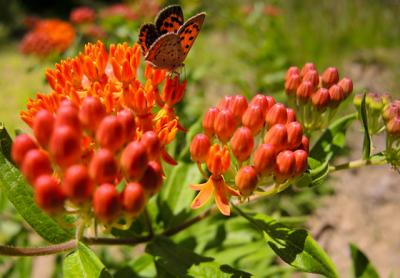Nature Notes: A Summer ‘Hibernation’

A new bird showed up in Montauk last week. It was a hummingbird, but not the one common in these parts, the ruby-throated hummingbird. This one had a black head. It turned out to be a black-throated hummingbird, a bird native to the Southwest. It was right at home feeding in the southwestern part of Hither Hills at one of Lois Markle’s hummingbird feeders. It hasn’t been back since.
At times a common bird on eastern Long Island can become a very unusual bird. Jean Held was surprised to see a male white-throated sparrow splashing around in her birdbath in eastern Sag Harbor. White-throated sparrows are common in the late fall, winter, and very early spring but go north to breed in the northern coniferous forest come mid-April. She left to get her camera, but when she got back to the window the bird was gone.
The intense heat impacts the natural acts of summer. Insects fly less and birds sing less and go around with open beaks to try to keep cool. When it gets as hot as it’s been this week, there is a kind of hibernation that takes place called aestivation. Nature’s land creatures tend to just hang out, flying as little as possible, sitting around, almost as inactive as in hibernation.
The weather people tell us it will be gone by the weekend. If so, we can look forward to the resumption of a spurt of normal activity, perhaps, even catch-up activity. Songbirds will begin their second broods if the conditions are more favorable. Osprey chicks are half grown and will be flapping their wings in earnest by mid-July. Mid-July is also the time when the shorebirds begin arriving back from the tundra. They hang around here with the natives until it starts to get a little cool in September and then they go south.
It’s been another good year for menhaden and the mature alewives of Big Fresh Pond, having bred in April, are ready to leave their breeding grounds to their scion, which will hang around for a few more months before heading out into North Sea Harbor come September.
The ranks of black-crowned night herons have been growing around North Sea Harbor in the past several years. Adults and immature night herons perch in the trees along the stream as they did in April, when the breeding migration got underway. They get the alewives coming and going, and going.
Mosquitoes have been kind to us thus far, but after the next rain predicted for the coming weekend, that might change. Butterflies have been scarce. So far I’ve seen a swallowtail or two and several cabbage whites. I can’t remember a bad cabbage white year. Jean Held has some orange milkweed, also called butterfly weed, blooming in her yard. These bloom weeks ahead of the native milkweeds, which are the favorite host plants of monarch butterflies. At this writing, she reported seeing the first one of the year on one of her milkweed blooms. Monarchs might be making a comeback after several record-low breeding years.
Milkweeds, especially the common milkweed with its white blooms, have been increasing their numbers locally during the last couple of years, on road shoulders, in old fields, and in other weedy areas.
The spring wildflowers have blossomed and set fruit. You won’t find a bird’s-foot violet or a lupine in July. Now it is the time of the orange flowers, the tiger lilies and daylilies, and here and there in the woods, the very rare native Turk’s-cap lily. The deer come by my place and eat some of the daylily heads before they bloom, but always leave several for Julie and me to enjoy when they burst open. Maybe they know that we like them and are returning the feelings.
After the spate of orange flowers come the yellow goldenrods, of which there are a lot of native varieties. The first to bloom is the early goldenrod, Solidago juncea, the last is the seaside goldenrod, the one that returning monarchs and butterflies hit on while moving along the coast in September. In the middle of the goldenrod season you might be lucky enough to find a few New England blazing stars and the federally endangered sandplain gerardia, which is barely holding its own in Montauk and a few other grassy spots on Long Island.
The last group of native wildflowers to bloom is the asters, of which we also have many different species. With either blue or white flower clusters, they begin at the end of August and last into November. What I haven’t told you about are the several native members of the orchid family, which start blooming in early summer and are gone by August. However, I’m not at liberty to tell you where they may be found. There is a nasty rumor going around that the deer are eating them all. Not true, but in the past, a lot of them have been wiped out by those who mow the town, county, and state road shoulders.
As soon as this heat exhausts itself, I’ll be out looking around; there is always a surprise or two waiting in the wings. Why don’t you tag along?
Larry Penny can be reached via email at [email protected].
